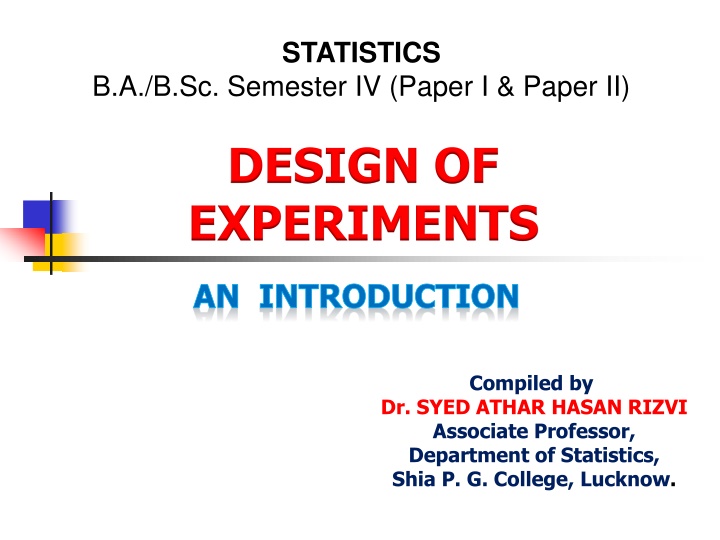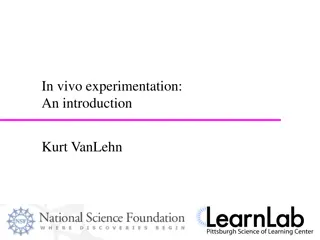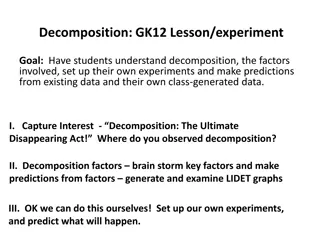
Introduction to Design of Experiments in Statistics
Design of Experiments is a crucial aspect of statistical analysis, involving logical planning to gather relevant observations for hypothesis testing. This article explains the importance of proper design, basic terminologies, and provides an example scenario. Understanding experimental units, treatments, fields, blocks, yield, experimental error, and accuracy is essential for conducting valid experiments in Statistics.
Download Presentation

Please find below an Image/Link to download the presentation.
The content on the website is provided AS IS for your information and personal use only. It may not be sold, licensed, or shared on other websites without obtaining consent from the author. If you encounter any issues during the download, it is possible that the publisher has removed the file from their server.
You are allowed to download the files provided on this website for personal or commercial use, subject to the condition that they are used lawfully. All files are the property of their respective owners.
The content on the website is provided AS IS for your information and personal use only. It may not be sold, licensed, or shared on other websites without obtaining consent from the author.
E N D
Presentation Transcript
STATISTICS B.A./B.Sc. Semester IV (Paper I & Paper II) DESIGN OF EXPERIMENTS AN INTRODUCTION Compiled by Dr. SYED ATHAR HASAN RIZVI Associate Professor, Department of Statistics, Shia P. G. College, Lucknow.
What is Design of Experiment? Design of Experiment is the logical planning of an experiment. This is done to obtain certain relevant observations regarding the hypothesis under study. These observations may confirm or may disapprove the hypothesis. The design includes: (i) planning of the experiment, (ii) obtaining observations from it and (iii) making a statistical analysis of these observations. 2
Importance of Design: sense that how the observations or measurements should be obtained to answer a query in a valid, efficient and economical way. The designing of the experiment and the analysis of obtained data are inseparable. If the experiment is designed properly keeping in mind the question, then the data generated is valid and proper analysis of data provides the valid statistical inferences. If the experiment is not well designed, the validity of the statistical inferences is questionable and may be invalid. Design means how to design an experiment in the 3
Basic Terminologies in Experimental Design: Experimental Unit or Plot: It is the smallest division of an experimental material to which a treatment is applied and on which the variable under study is measured. The experimental unit is randomly assigned to treatment. Eg. A patient, a plot of land etc. Treatment: An object or procedure whose effect is measured and compared is called a Treatment. Eg. A set of drugs, fertilizers etc. Field: The set of all experimental units is called Field. Eg. Total No. of patients under treatment or the total land under experimentation. Block: The total experimental material is subdivided into different strata. These strata are called Blocks. 4
Basic Terminologies ..continued. Yield: The experimental results given by different plots are measured and are termed as Yields. Experimental Error: Variation between the yields of different plots, caused by non-assignable factors is called an Experimental Error. Eg. Lack of uniformity in the experimental material, the variability in the methodology of conducting the experiment from unit to unit. Accuracy: To make an experiment accurate, it should be so defined as to make all its plots equally affected by the factors other than the treatments. Accuracy may also be called unbiasedness. 5
An Example: (Ref.: Statistical Design, G. Casella, Chapman and Hall, 2008) Suppose some varieties of fish food is to be investigated on some species of fishes. The food is placed in the water tanks containing the fishes. The response is the increase in the weight of fish. The experimental unit is the tank, as the treatment is applied to the tank, not to the fish. Note that if the experimenter had taken the fish in hand and placed the food in the mouth of fish, then the fish would have been the experimental unit as long as each of the fish got an independent scoop of food. 6
Main objectives of a good Experimental Design: 1. The design should be accurate or unbiased. 2. It should give a valid measure of of the experimental error, by making a sufficient control over undesirable influences. 3. The design should be sufficiently sensitive. 4. The design should give unbiased estimates of the treatment effects. 5. The design should have a wide scope of its application. 7
Principles of an Experimental Design: There are three main techniques or basic principles of a design: (i) Replication, (ii) Randomization and (iii) Local Control 1. Replication: The repetition of the treatments under study is called Replication. In the replication principle, any treatment is repeated a number of times to obtain a valid and more reliable estimate than which is possible with one observation only. Replication provides an efficient way of increasing the precision of an experiment. The precision increases with the increase in the number of observations. Replication provides more observations when the same treatment is used, so it increases precision. then the is of variance the if example, For x = 2 variance of sample mean based x ( ) x ( ) x 2 replicatio r on (observati ns ons) is increases, as so r the decreases. Var Var r Thus the experimental error goes on decreasing with an increase in the number of applications. It makes the design more efficient or sensitive. 8
Principles of Design continued -1 2. Randomization: The principle of randomization involves the allocation of treatment to experimental units at random to avoid any bias in the experiment resulting from the influence of some extraneous unknown factor that may affect the experiment. In the development of analysis of variance, we assume that the errors are random and independent. In turn, the observations also become random. The principle of randomization ensures this. The random assignment of experimental units to treatments results in the following outcomes: a) It eliminates systematic bias. b) It is needed to obtain a representative sample from the population. c) It helps in distributing the unknown variation due to confounded variables throughout the experiment and breaks the confounding influence. 9
Principles of Design continued - 2. Randomization forms a basis of a valid experiment but replication is also needed for the validity of the experiment. If the randomization process is such that every experimental unit has an equal chance of receiving each treatment, it is called complete randomization. 3. Local Control: In this technique, experimental units are divided into homogeneous groups or blocks. The replication is used with local control to reduce the experimental error. For example, if the experimental units are divided into different groups such that they are homogeneous within the blocks, then the variation among the blocks is eliminated and ideally, the error component will contain the variation due to the treatments only. This will, in turn, increase the efficiency and make the test procedure more sensitive or powerful. 10
Steps in Designing an Experiment: 1. Statement of the problem or the object. 2. Formulation of Hypothesis. 3. Study of the experimental sight 4. Choice of an experimental technique. 5. Performance of the experiment. 6. Collection of the results and their statistical analysis. 7. Decision about the results obtained. Some elementary designs are: Completely Randomized Design (CRD), Randomized Block Design (RBD) and Latin Square Design (LSD) etc. 11
References: 1. Applied Statistics (Text Book) by Ansari M. A., Chaudhary S. S. and Gupta, O. P. , Published by Ram Prasad and Sons, Agra (1972). 2. Analysis of Variance (Chapter 4) Experimental Designs & Their Analysis (pdf) by Shalabh, IIT Kanpur 12






















